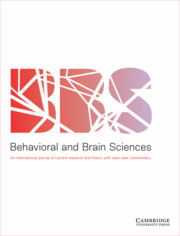Crossref Citations
This article has been cited by the following publications. This list is generated based on data provided by Crossref.
Kanning, Uwe Peter
2017.
Personalmarketing, Employer Branding und Mitarbeiterbindung.
p.
51.
Schmälzle, Ralf
Imhof, Martin A.
Kenter, Alex
Renner, Britta
and
Schupp, Harald T.
2019.
Impressions of HIV risk online: Brain potentials while viewing online dating profiles.
Cognitive, Affective, & Behavioral Neuroscience,
Vol. 19,
Issue. 5,
p.
1203.
Mansell, Jordan
2020.
Ideology and social cognition.
Politics and the Life Sciences,
Vol. 39,
Issue. 1,
p.
9.
Feng, Cailing
Robin, Mulyadi
Fan, Lisan
and
Huang, Xiaoyu
2020.
Commitment to change.
Personnel Review,
Vol. 49,
Issue. 5,
p.
1069.
Thomaidou, Mia Athina
Veldhuijzen, Dieuwke Swaantje
Peerdeman, Kaya Joanne
Wiebing, Naomi Zoë Sifra
Blythe, Joseph Sullivan
and
Evers, Andrea Walbruga Maria
2020.
Learning mechanisms in nocebo hyperalgesia: the role of conditioning and extinction processes.
Pain,
Vol. 161,
Issue. 7,
p.
1597.
Klevsky, Elena
and
Huber, Marsha M.
2021.
Serendipity in Accounting: Teaching Students How to Navigate a Changing World.
Issues in Accounting Education,
Vol. 36,
Issue. 4,
p.
291.
Mazur, Lucas B
and
Sztuka, Mariusz
2021.
Hidden harmony: Converging interests in the development of prison reform.
Theoretical Criminology,
Vol. 25,
Issue. 1,
p.
149.
Acland, Daniel
2021.
Poverty, Irrationality, and the Value of Cash Transfers.
Journal of Benefit-Cost Analysis,
Vol. 12,
Issue. 2,
p.
227.
O’Shea Brown, Gillian
2021.
Healing Complex Posttraumatic Stress Disorder.
p.
91.
Canache, Damarys
Mondak, Jeffery J.
Seligson, Mitchell A.
and
Tuggle, Bryce
2022.
How Bad is Bad?: Dispositional Negativity in Political Judgment.
Political Behavior,
Vol. 44,
Issue. 2,
p.
915.
Llavona-Ortiz, Josheili Y.
Spanos, Katherine E.
Kraschnewski, Jennifer L.
D’Souza, Gail
Myrick, Jessica Gall
Sznajder, Kristin K.
and
Calo, William A.
2022.
Associations Between Human Papillomavirus Vaccine Decisions and Exposure to Vaccine Information in Social Media.
Cancer Control,
Vol. 29,
Issue. ,
Miao, Kuan
Liu, Xuerong
Zhang, Xiaoling
Li, Yuanyuan
Liao, Xingya
Zhang, Rui
Feng, Zhengzhi
and
Chen, Zhiyi
2022.
Revision and psychometric properties of the negative cognitive processing bias scale.
Frontiers in Psychiatry,
Vol. 13,
Issue. ,
Hren, Darko
Pina, David G.
Norman, Christopher R.
and
Marušić, Ana
2022.
What makes or breaks competitive research proposals? A mixed-methods analysis of research grant evaluation reports.
Journal of Informetrics,
Vol. 16,
Issue. 2,
p.
101289.
Flannery, Caragh
Hennessy, Marita
Dennehy, Rebecca
Matvienko-Sikar, Karen
Lucey, Con
Dhubhgain, Jennifer Ui
and
O’Donoghue, Keelin
2023.
Factors that shape recurrent miscarriage care experiences: findings from a national survey.
BMC Health Services Research,
Vol. 23,
Issue. 1,
Silva, Gabriella
Rum, Ruba
Brennan, Justine
Rottenberg, Jonathan
and
Goodman, Fallon R.
2023.
What allays loneliness? A fine-grained examination of daily social interactions.
Journal of Social and Personal Relationships,
Vol. 40,
Issue. 11,
p.
3585.
Watson, Joe
van der Linden, Sander
Watson, Michael
and
Stillwell, David
2024.
Negative online news articles are shared more to social media.
Scientific Reports,
Vol. 14,
Issue. 1,
O’Shea Brown, Gillian
2024.
Komplexe posttraumatische Belastungsstörung heilen.
p.
101.
Fletcher, Henry W.
and
Aunger, Robert
2024.
Understanding Mass Panic.
Journal of Applied Social Science,
Vol. 18,
Issue. 2,
p.
288.
Dai, Yuelian
Zheng, Ya
Hu, Kesong
Chen, Jingyan
Lu, Shan
Li, Qi
and
Xiao, Jing
2024.
Heterogeneity in the co-occurrence of depression and anxiety among adolescents: Results of latent profile analysis.
Journal of Affective Disorders,
Vol. 357,
Issue. ,
p.
77.
Galende-Sánchez, Ester
Sorman, Alevgul H.
González-Eguino, Mikel
González-Medina, Moneyba
and
Gómez-Fortes, Braulio
2024.
Behind the curtains of deliberation: unveiling climate policy and behavioural challenges through a mini-public in Spain.
Journal of Environmental Policy & Planning,
Vol. 26,
Issue. 4,
p.
402.


Target article
The negativity bias: Conceptualization, quantification, and individual differences
Related commentaries (1)
Differences in negativity bias underlie variations in political ideology